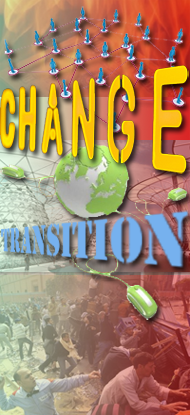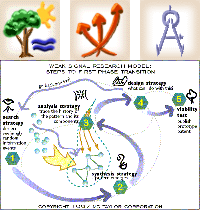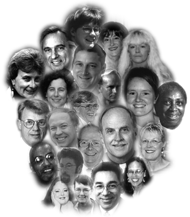MG Taylor Corporation: The Mission
The MG Taylor Mission |
The mission of MG Taylor has its roots in the original mission of Taylor Associates in 1983. Essentially, that mission remains unchanged in its concept. It has been updated from time to time by way of explanation of what the various elements mean at a given moment in time. Below, the original mission is presented, element by element and side-by-side, with the current explanation of each element. |
ORIGINAL ELEMENT |
EXPLANATION |
"Our World is going through ..."

|
By WORLD we were not speaking metaphorically. Our intention from the beginning was — and remains — to change the way of working globally. This does not mean we intend to be a huge corporation. Far from it, we are on this path by employing the same system and method we bring to our clients.
Our goal is ubiquity. Our intent is to apply our methods to function in all cultures, all places — used in all circumstances and applications.
GOING THROUGH is a description of the state of things then and now. This is a protracted process. It is not about fixing some things then returning to a happy steady-state. This is wave on wave of disruptive change. Huge in scale, total in scope, deep in the character of the change. This transformation will take two generations and we are about at the halfway — and most likely — the point of greatest danger. To many of us it will seem like a long time. On the scale of civilizations, it will be a flash. |
"… its biggest transition in known history."

|
There are two points being made here. One is the unprecedented scope of this change and the other is a reminder that several such transformations have occurred in history and, we suspect, in “pre-history.” In KNOWN history is a deliberate choice of words. There are too many indicators that what we “moderns” think of as originating civilizations are are in fact fragments of a prior more sophisticated era. This is important because we (the human race) should be aware that it is possible to bungle this global transition with catastrophic results. Success is not a given. It is not a given on the level of an individual enterprise and it is not a given for the enterprise called the human race — or Planet Earth for that matter.
What is happening is a TRANSFORMATION of not only global society but our global ecological system. Notice, however, the focus of our Mission Statement is on the transition from one era to another. Transformations, by definition, are emergent. They cannot be understood, predicted nor controlled. Management of the factors brought to specific transitions is possible and this cuts to the heart of our system and method.
The design assumption that we brought to our work was that if the human race continued to think, work, govern itself and expand its enterprise as it had in the past that it would most likely destroy far more than it created and put itself, most species and the planet at major risk. We believe — after 30-plus years of testing these assumptions in the application of our work with clients — there is no reason to change that point of view today.
There is ample evidence that there is strong linkage between mind organization, enterprise organization and planetary outcomes. There is ample evidence that humans and human organizations can rapidly change and do far better with systemic issues than the record of the past indicates — indeed, that they will do so, given the necessary tools. There is ample evidence that we are in a race between how fast we will change and the damage we are doing by the kind of change we are creating. We face many potential tipping points that lead to dangerous consequences capable of coming upon us far faster than we can adequately respond to. This is the danger.
We started the Taylor enterprise feeling that we were very much in a race with the future. It feels that way today. The good news is the danger of which we speak is much better defined than at our beginning. We know our methods — just ideas in 1975 — work. We know people will employ them and that they can be effectively transferred. If used at the right scale and scope for the right kind of projects, humanity can become requisite with the change we face.
|
"Some call this the Post Industrial Society — others, the shift from the industrial to the information era — still others call it The New Age."

|
It does not matter what it is called. Any definition — from this side of transformation — is not going to be accurate nor complete. The "New Economy" has come and gone in a flash — though there was little that was “new” about it. However, there are a number of characteristics of this new era — or at least the transition period to it — that are clear.
- It will involve extensive use of network structures from neural nets, to computer architecture to organizational strategies.
- It will be knowledge-based and design focused and will involve an entirely new sense of what is value-added work.
- It will employ both local and global economies.
- It will experience wave after wave of disruptive technologies.
- Systemic issues will be preeminent and it will involve operating complex networks of organizations with myriad, shifting interdependencies.
- It will result in a profound shift in power, access and social structure.
- Dichotomies like ecology versus economy will disappear.
These patterns have been apparent for more than 35 years, and they are still growing in strength. There are no surprises here. What is likely to be surprising is how these patterns combine and play out — and combine with new patterns not yet apparent. |
"From the ranks of business, the professions, government, education and religion, a group of workers are emerging who are taking respon-sibility for steering these changes with craft and excellence."
 |
It was the invisible college concepts of Boulding (1968) and Dahl (1972) that stimulated our thinking about the TRANSITION MANAGER. Our own experience in the 70s and early 80s convinced us that this would be a knowledge worker focused social/economy as defined by Drucker (1967) and that a sub-set of this new “worker” would specifically take on the task of managing transitions be it an organization, a geopolitical region, a nation or a global, transnational entity or process. These individuals, acting under their own authority (Fuller’s anticipatory design science concept) - no matter their organizational affiliations - are the people we decided to support. This was, on their part, a “stepping up ” process to use our own term of art.
This means that we have never defined our “market” in the narrow traditional terms such as an industry category. It means we have to “reach” a broadly diverse and distributed group. It means we do not work for organizations - we work for individuals most of whom happen to be affiliated with an organization for some period of time (Toffler, 1961 “Ad-Hocracy”). |
"We call these individuals Transi-tion Managers."

|
The Transition Manager is a foundational concept to our Enterprise Model. Our own organizational experience and the work with our client patners evolved the ValueWeb℠ concept in the early 1980's, which over the past 20 years has become our organizational operating structure.
We developed the CREED for the Transition Manager as both guide this individual in their own quest and to act as an ethical framework governing our own actions. This creed specifically addresses the special context of social transformation and the responsibilities of those who choose to take on the task of facilitating the leap across “the abyss.” This is why "for profit" professsional service organizations that forget their fiduciary duty to their clients are so dangerous. |
"The Mission of MG Taylor is to educate, train, facilitate and support the Transition Manager."

|
We do this in a new way. We do this by creating a total environment — physical, informational, psychological, intellectual, energetic — around the Transition Manager and co-workers. We do this while helping them solve real-world problems in a way that promotes and leads to improved systemic, long term solutions.
It is through this experience that we transfer a new way of working to the Transition Manager and their organization(s) and ValueWeb.
Our goal is to increase the capacity of individuals and organizations to deal with rapid change and complexity. Our starting premise was — and it has been confirmed again and again — that when people have the capability they will “trade up” in regards how they define and solve problems. Compromises and narrow, provincial, dead-end “solutions” are avoided. Individual and system health is promoted. This premise has long been the moral basis of our Enterprise. |
"We do this by: ..."

|
"Creating Environments ... Facilitating processes ... Providing Implementation Methods and Tools."
The integration, synergies and interoperability between physical environment, work processes and augmentation tools is the heart of our System and Method.
Making these environments, using them, transferring them to their ultimate users... This is our WORK.
These environments are neutral places where people from different organizations can bring different viewpoints and models in a non-attribution social system. These environments are specially designed to promote creative processes, collaboration and GroupGenius℠. They are equipped to carry ideas though to the production of objective artifacts and working prototypes — the complete creative process not just the “front-end” as was the habit in the past.
These environments perform Weak Signal Research and solve real-world problems. They are wired into the society of which they are a part. They facilitate Appropriate Responses to the challenges before their users. They are places of integrity - they exemplify the kind of future they seek to bring into reality. |
"Our goal: A global network of Management Centers, user owned and operated, supporting transition managers in their quest for excel-lence."

|
The goal has been and remains: UBIQUITY.
We are building a network — a global “brain/mind.” An intellectual “replacement economy” (Jacobs). We called these NODES Management Centers then. Today, they are NavCenters™ such as Borgess, NASA or Vanderbilt — or the World Economic Forum's WorkSpace. They are schools, like Masters Academy & College in Calgary; or Learning Exchanges in the Veterans Health Administration network. These Nodes are part of an ever-expanding ValueWeb; they share non-competitive information and intelligence. They share process improvements and exchange KnowledgeWorkers. Together, as competitors, as cooperators, they evolve the craft of knowledge-work, facilitation and transition management.
They house and support Transition Managers and their projects. They facilitate Transition manger’s QUEST and Right Livelihood. They help them achieve their ART. By doing this, the Centers (nodes) become active agents in global transformation.
A concept that came out of the Renascence Project Library (1975-1979) was EARTH LIBRARY. The idea was to have a series of facilities placed around the globe so that when anyone became aware of personal/social transformation they could walk to one to find ideas, information, tools, support and connections. The NavCenter is a more sophisticated version of this idea. In 1982, Matt Taylor mapped the number of Centers it would take to be within a half a days journey of 50% of the US population. Now, today, this is accomplished and the network is expanding globally. There is a “Taylor” facility of some kind that more or less equals this “reach.”
We are on the threshold of a critical mass of Centers demonstrating proof of concept of the network assumptions behind our network strategy.
Most of these NavCenters are focused on their organizations' immediate tactical problems. Long term success, both local and global, will require a shift to including strategic and systemic solutions which are connected center-to-center around the globe. This is the key aspect of the strategy which will be critical at specific moments of large-scale social change. |
"The result: The rebuilding of planet Earth as a work of art, created and enjoyed by all people."

|
This, of course reveals the true level of ambition of the Mission. We really meant this. We still do. We do not believe that the complex problems — problems that challenge the survival of many species including our own — can be met any other way.
The earth is now a human artifact. There is no changing this. The question is how it evolves from this point. If it survives as a viable HABITAT shared by animals and humans in an equitable way — and a sustainable way — it will be a product of human/nature co-design. It will be both system and organic — a product of intentional design and heuristic evolution.
Today, the SUM of human impacts — on humans, on animals, on GAIA — is accidental, unintended and immensely damaging. There is talk of “trade-offs” and so on, but this is really not the case. The reality is we are designing our world by default.
We see this process as a REBUILDING. This is because we have destroyed so much. A great deal of restoring is necessary, however, this is not an advocacy for “going back.” First, we cannot. Second, the idea is to create something that is more than what was. We humans can become creators, not destroyers; collaborators, not dominators. We can be part of bringing a new level of life to our existence and our place which is now planet Earth.
It is not necessary to point out that these goals are audacious. They are more than that. One thing that can be learned from Bucky Fuller, and the way he lived his life, is that a single individuals can make a tremendous difference if they try — and stay on it over a long period of time. Timing, of course, is everything. This is the strategy behind ANTICIPATORY DESIGN. Do Weak Signal Research, bracket the interesting and scope of possible, prototype tools, products and services in anticipation of needs so that they can exhibit a significant degree of maturity when humanity discovers the need. Track this process, then, implementation is possible without the usual lag time required to go from idea to use. Be ready to scale the organization in support of each client/user implementation when, where and how it is required. This is our mandate. |
This is what we took on. We took this on as a for-profit corporation because we wanted to demonstrate that our work and ideas were practical (can be practiced) in our society. The Transition Manager has to be competent in both the world that is and the world that is becoming.
How have we done?
MG Taylor Mission has, as a consequence, a number of implications to how we do business that are uncommon to “normal” practice. We have been managing these inherent dilemmas now for three decades. The “dilemmas” remain because they are integral to the difference of social economic legal reality we are in and and reality we are working to bring about. The actions we take in regards these have to change, as conditions change, else they become a self-defeating organizational habit. The dilemmas themselves will not go away until the transition itself is accomplished. Many who come to MG Taylor try to remove the dilemmas by attempting to change the Enterprise “back” into a traditional corporation. They argue that money, legal, contractual, organizational issues will be better handled. That risk will be reduced and profits enhanced. They are probably right. The problem is the compromise this brings to the Mission. This cannot be allowed to happen. The business objective is to be profitable and sustainable while accomplishing the Mission not to be “successful” at any sacrifice to why this Enterprise was created.
We want to succeed at what we set out to do — but not just succeed by some arbitrary social standard of what success is. The ubiquity of the model that today defines social success is, perhaps, the most destructive meme on the planet. It must be reexamined. This planet cannot take another 25 years of it .
We have entered into a time of alignment. The people of Earth — on a much larger scale than ever before — have finally turned their attention to these complex, systemic issues, these worthy problems. Even though — for everyone from individuals to companies to nations to the entire civilization of mankind — short-term survival is a much more acute and urgent issue (because of the very nature of a much higher level of connectedness) than in many years, there is a strong awareness of the larger issues of sustainablity, renewal, and re-creation in terms of society, the global and local economy, and the environment. Technology has advanced to the point where it can be robustly incorporated, as tools, into the MG Taylor patented System and Method. Concurrently, MG Taylor has created a step function improvement in its System and Method. In fact, our nextGen℠ line of products and services is to the DesignShop℠ what the DesignShop was to other forms of collaboration existing in the 1980s.
We are ready to step up to the challenges of today — and tomorrow — with the most advanced form of an INTEGRATED SYSTEM of collaborative services and products to be found on Earth. |
|
 MG Taylor Corporation
MG Taylor Corporation 